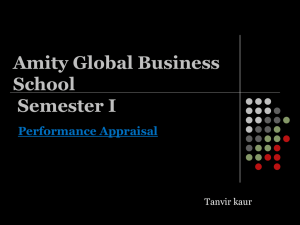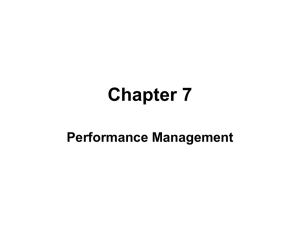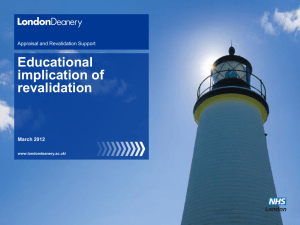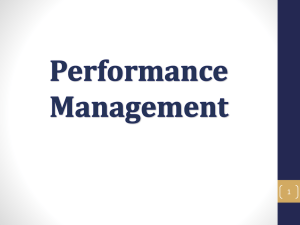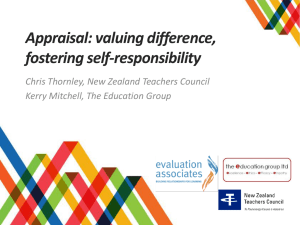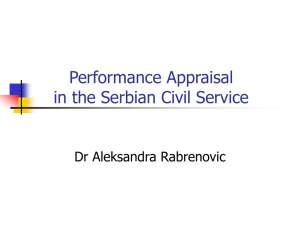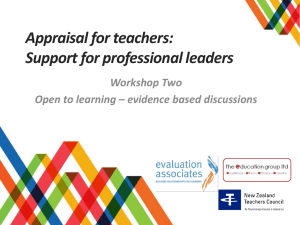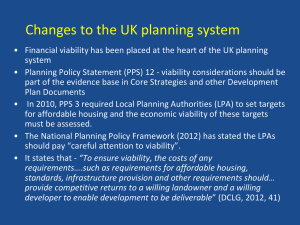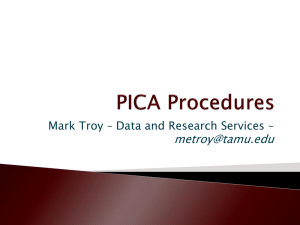Insurance Appraisals - The State Office of Risk Management
advertisement
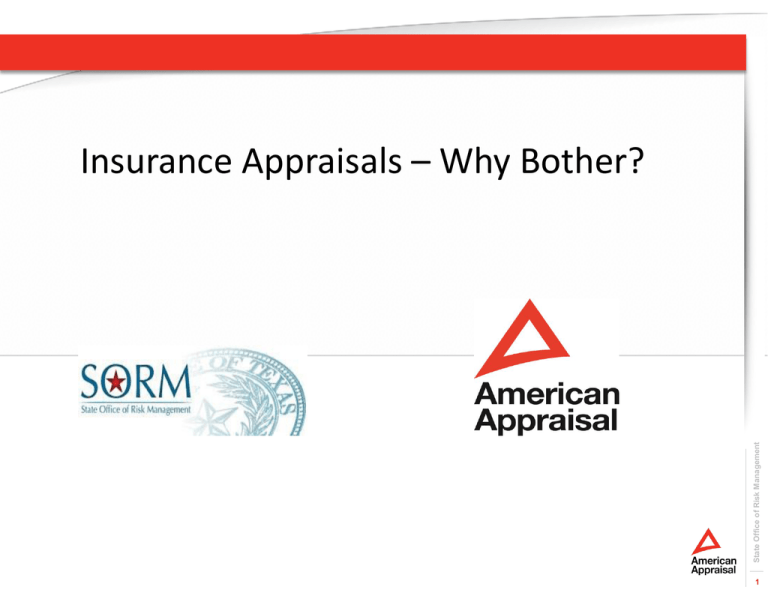
State Office of Risk Management Insurance Appraisals – Why Bother? 1 Changes in Underwriting State Office of Risk Management Improved underwriting discipline dictated by the markets Increased emphasis on a consistent, disciplined approach to underwriting: • Exposure data analysis (valuation and COPE data) • Loss experience analysis Increased focus on geography Appraisal requirements for insured properties Ever-changing catastrophe models affect expected loss predictions (PML and AAL) Carriers are requiring more data and many standard markets are cutting back capacity, especially in high hazard areas. 2 Questions to Ask Yourself State Office of Risk Management Are you confident that your statement of values accurately reports all of your insurable property? Have you kept pace with the change in assets within your facilities? Do you know where your properties’ data came from? How well was your statement of values received when last marketed? Did you receive pushback from underwriters? 3 Cost Trends State Office of Risk Management 1986-2003 (2% inflation/increases per year) Significant construction inflation in 2004 (10.5%) Slowing from 2005-2007 Commodities caused drastic increases in 2008 Prices fell back with economy in 2009 Inflation stabilized in 2010-2011 Most recent 12 months: 3% Outlook for remainder of 2014: 2% 25% - 30% inflation in seven years 4 COPE Data Defined State Office of Risk Management Underwriters are interested in receiving more than just a valuation, they also want COPE data: • Construction (frame, brick, masonry, masonry veneer, etc.) • Occupancy (how the building is being used) • Protection (quality of the responding fire department, adequacy of water pressure & water supply, the presence or absence of smoke alarms, etc.) • Exposure (risks of loss posed by neighboring property or the surrounding area -takes into consideration what is located near the property, such as an office building, a subdivision or a fireworks factory) 5 Why is COPE Data Important? State Office of Risk Management Used in catastrophe modeling programs • Applied to individual insureds and insurance company property portfolios • Uses historical data ‐ Financial ‐ Meteorological ‐ Engineering • Estimates losses for catastrophic (CAT) events • Adopted by insurers and rating agencies in CAT management and financial analysis models • Defaults to worst-case scenario if data is not available 6 CAT Risk Modeling: True Impacts The entire insurance industry is impacted by CAT Modeling, no matter which software package is used: State Office of Risk Management • RMS • AIR • EQECAT • Proprietary/blended models Models are constantly updated 7 How do Insurance Companies use CAT Modeling? State Office of Risk Management The goal of CAT modeling is to lend consistency to the overall cost of risk Manage aggregate exposure over their entire portfolio of risk Purchase re-insurance protection Underwrite individual risks (impact on the overall portfolio of risk) Charge the appropriate premium for the risk 8 How do Insureds use CAT Modeling? State Office of Risk Management See how the insurance industry views your risk Have an idea of your expected losses and/or your Probable Maximum Loss (PML) Identify high hazard locations Aid in determining/purchasing “adequate” limits 9 Primary COPE Data – most crucial information State Office of Risk Management Occupancy type Number of Stories Class of construction Year of construction 10 Secondary COPE Data State Office of Risk Management More detailed structural / location specific data elements, specific to • Windstorm/Hurricane • Earthquake Primary COPE data must be reported for the Secondary factors to apply and matter The concern relates to maintenance of the building envelope during an event to protect the contents: • How solid are the walls? • How strong is the roof & covering? • How susceptible to peril are the contents? 11 Benefits of Accurate COPE Data State Office of Risk Management CAT modeling for hurricanes and earthquakes has become an essential resource for all parties in the property insurance marketplace Proper inclusion of data has significant impact on modeling results Detailed info about a building’s construction and usage provide a predictive image of how the building will react in the event of a catastrophe Accurate data can help the underwriter, broker and insured better understand true exposures This knowledge of expected losses helps insureds and insurers set acceptable program structure and sublimits Better data leads to better decisions 12 Actual Renewal Results State Office of Risk Management Additional underwriting data has produced significant reductions in the PML and AAL estimates and lower premiums for many accounts Additional underwriting data and has made it easier to buy more insurance coverage for many accounts Additional underwriting data can make accounts more attractive to insurance carriers – increased competition can yield better results Increased data can also help significantly post-loss: Eliminates argument on building valuations or condition of building 13 Insurance Appraisal of Buildings – Methodology – How it’s done Unique Structures Universities (stadiums, libraries, hospitals, research facilities, historically significant) Water and Wastewater Treatment Plants Airport Facilities Historic Properties State Office of Risk Management Component-Based Appraisal Methodology Conduct an on-site inspection and appraisal of every structure Measure dimensions/perimeter Review as-built plans Obtain GPS coordinates Gather descriptive and locational details Determine construction components Review building services, interior and exterior finishes, etc. Photograph each building Develop replacement cost using local construction cost resources Report values and COPE (primary and secondary) data by building 14 Primary and Secondary Windstorm Data that is Collected Occupancy Address Class of construction Year of construction Square feet of space Number of stories Average story height Wall construction Roof construction Heating system Cooling system Fire alarm Sprinklers Entry alarm GPS coordinates Secondary COPE Data Construction quality Roof covering and geometry Roof age/condition Roof anchor and equipment bracing Basement Appurtenant structures Cladding type Roof sheeting attachment Frame/foundation attachment Ground-level equipment Opening protection Flashing and coping quality Content grade Flood zone determination RMS/AIR-specific construction codes RMS/AIR-specific occupancy codes State Office of Risk Management Primary COPE Data 15 Historic Structures The most visible differences between historical and modern structures are the interior and exterior finishes: Floors Walls Ceilings Windows Doors Special architectural features State Office of Risk Management Inspection and appraisal process is expanded for historical structures to identify and record the nature of interior and exterior finishes during the inspection process for consideration of the related costs during the final appraisal process. 16 Valuation Solutions - Contents State Office of Risk Management Appraisal Programs ‐ Contents/personal property valued by modeling approach • Recommended when personal property is of much less significant value than real property • Based on appraisal company’s prior full surveys of similar occupancies • $/SF used and adjusted when necessary by appraisal staff • Typical for public-sector occupancies 17 Valuation Solutions - Contents State Office of Risk Management Appraisal Programs ‐ Detailed asset listing by comprehensive site inspection • Recommended for capital-intensive manufacturing plants • Inspected and inventoried ‐ Asset number, description, model number, serial number and manufacturer • Predetermined equipment listing cut-off (greater than $100,000 suggested) • Logical production lines and single assets with replacement cost greater than $100,000 listed • Asset below this cost grouped with like kind assets • Assets repriced using a variety of sources • Values reported by floor by building • Typical for HPR (highly protected risk) occupancies 18 State Office of Risk Management Sample Appraisal Report 19 How to Order an Appraisal State Office of Risk Management Within the SORM program, discuss with Michelle Tooley and Chris Connelly/AJG to identify the structures to be appraised • Will realize volume discount pricing that has been negotiated between SORM/AJG/American Appraisal Outside the SORM program, contact Lori Flemming to discuss appraisal needs at your institution. Appraisal fees will be somewhat higher given the “one-off” nature request. 20 How to Prepare for an Appraisal Contact your departments to alert them to our site visit Provide name/contact details of department liaisons • preferably plant operations or maintenance personnel who have knowledge of the buildings’ history If blueprints or CADs are available, it would be useful for our staff to have access to review prior to inspection State Office of Risk Management Provide identification/badge or letter to let others know we have permission to be on site 21 Benefits of Insurance Appraisals through SORM State Office of Risk Management Determine the adequacy of insurance coverage Improve risk management Create confidence in the accuracy of values Eliminate surprises at the time of loss Ensure preferential underwriting treatment Create a basis for preparation of “proof of loss” for clients Substantial discounts by working with American Appraisal within the SORM program 22 American Appraisal’s Insurance Appraisal Practice Established Established in 1896 to provide independent property appraisals for use in adjustments and settlements between insurance companies and property owners Full-time, permanent employees (no subcontractors) Full-time Serve numerous public entities (State govts, higher ed, healthcare) Diverse Dedicated Public Entity Practice Group Dedicated Inspect/appraise 30,000+ buildings annually for insurance purposes Global Regional access to American Appraisal’s global reach Text Here State Office of Risk Management Accessible 23 Professional Qualifications Lori is a Managing Director of business development for American Appraisal in the southeast United States. She has served in her current position since 1992. Prior to joining American Appraisal, Lori spent five years as an officer in the United States Air Force, Space Command. Education University of North Carolina at Chapel Hill, Bachelor of Arts - Psychology Webster University, Colorado Springs, CO, Master of Arts - Satellite/Space Systems Management Certification - SAPs Finance/Control Module Managing Director Contact Information Phone: +1 704 953 9780 lflemming@american-appraisal.com Professional Affiliations Risk and Insurance Management Society (RIMS) University Risk Management and Insurance Association (URMIA) Public Risk and Insurance Managers Association (PRIMA) State Office of Risk Management Lori C. Flemming 24 Thank you for choosing American Appraisal. State Office of Risk Management We look forward to working with you. 25
